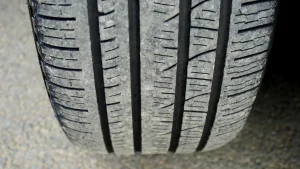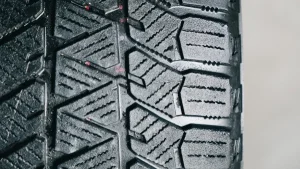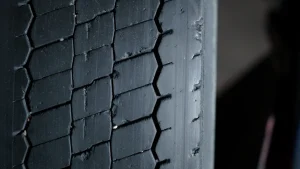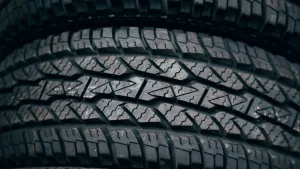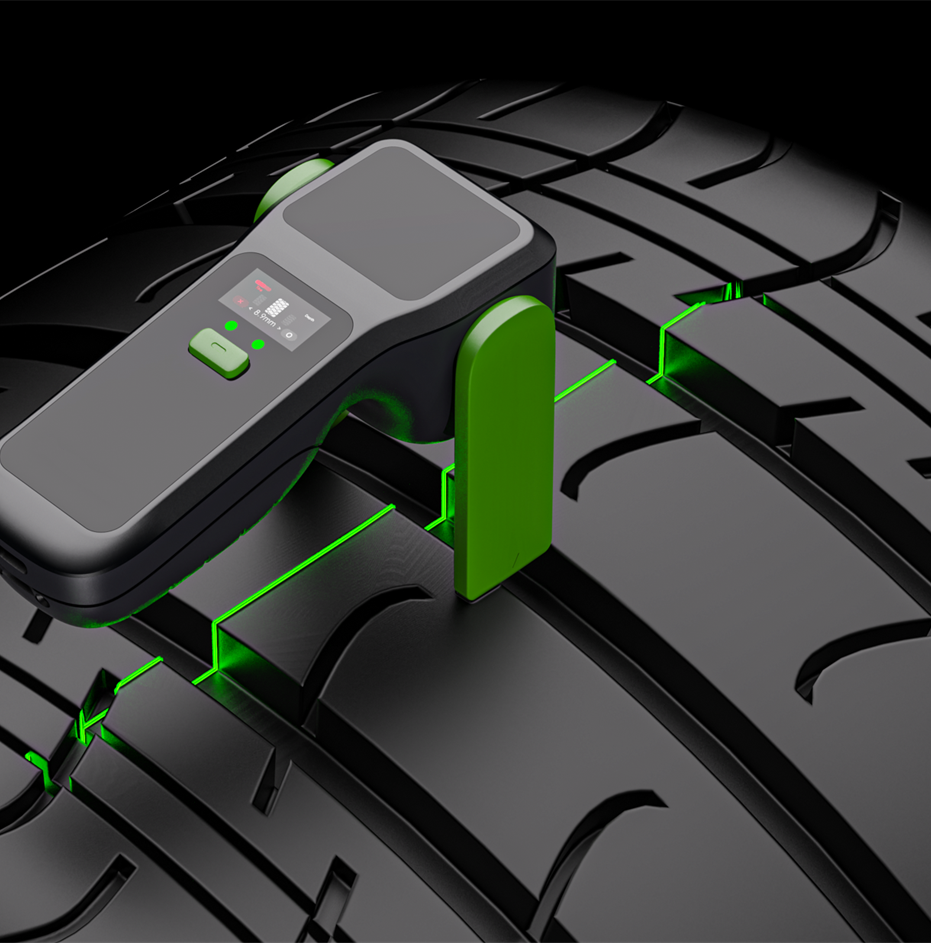
A smart tire tread depth detector lets you check tread depth fast and correctly. This device uses new technology like laser imaging to look at your tire tread without touching it. You see the results right away on a screen, so you can find unsafe tread or uneven wear quickly. Tread depth is important for your safety and how well your car works. In the last five years, more drivers and fleet managers use these smart detectors because of stricter safety rules, better technology, and the need for good tire data.
More people use them because:
Safety rules are stronger in North America and Europe
AI and wireless sensors are getting better fast
People know more and digital choices cost less
Key Takeaways
Smart tire tread depth detectors have special sensors and lasers. They check tire tread fast and do not touch the tire.
These devices give alerts right away about tire wear, pressure, and heat. This helps drivers stay safe and avoid crashes.
Using smart detectors saves time and money. They find tire problems early. This helps tires last longer and saves gas.
Smart tire sensors work for one car or many cars. They give easy reports and help plan when to fix tires.
When used with telematics systems, users can check tire health from far away. This helps people make better choices about repairs and safety.
Smart Tire Tread Depth Detector
Definition
A smart tire tread depth detector lets you check tread depth fast and easily. You use it to see how much tread is left on your tires. This helps keep you safe while driving. The detector uses special sensors and technology to show you tire health right away. Old manual gauges need you to check by hand, but smart detectors work without touching and show results right away.
There are two main types of these systems. Some have sensors inside the tire. These sensors watch tread depth, tire pressure, and temperature as you drive. Other systems use a sensor pad you drive over. When you drive over the pad, it checks the tread depth for each tire. Both types let you check your tires without stopping to look by hand.
Handheld smart tire tread depth detectors look like small scanners. They use laser imaging or special light to scan without touching. You hold the device near the tire, and it finds the grooves and measures tread depth. Most have a laser, a lens, a touchscreen, a power button, a USB Type-C charging port, and wireless features like Bluetooth or Wi-Fi. You can use them alone or with your phone or tablet. The touchscreen shows curves, tread wear, and tips for care. Some send reports to your phone or fleet system.
Note: Smart tire tread depth detectors can warn you when to change a tire, check wheel alignment, or fix tire pressure. This helps drivers, mechanics, and fleet managers.
How It Works
Smart tire sensors use different ways to measure tread depth and tire health. Sensors inside the tire collect data as you drive. They track tread depth, air pressure, and temperature. The data goes to your car’s computer or to the cloud for checking. For example, accelerometer sensors inside the tire are very stable and accurate, but real roads can make them less perfect.
Platform-based systems use a sensor pad you drive over. The IntelliTread drive-over system works like this. When your car goes over the pad, the sensors check tread depth for each tire. The system sends this data to the cloud. Smart computer programs and AI look at the data, compare it to other cars, and warn you about tire problems before they happen. This way gives you better accuracy and more warning time than just using sensors inside the tire.
Some smart tire tread depth detectors, like the MaxiTPMS TBE200, use laser measurement. You scan the tire, and the device checks tread depth with 0.1mm accuracy. The touchscreen shows results, like uneven wear and brake disc wear. The device can give you tips for care based on the data. You get hands-free, real-time checks, so you can make quick choices about your tires.
NIRA’s Tread Wear Indicator uses software and sensors already in your car to watch tread wear. It does not need extra hardware. The system checks tread depth and wear patterns, then sends alerts to you or your fleet manager. This helps you keep your tires in good shape and saves fuel.
Sensor Type | Stability (Mean SNR in dB) | Linearity (R²) |
|---|---|---|
Accelerometer | 0.9943 | |
PVDF | 37.17 | 0.9903 |
This table shows that accelerometer sensors inside tires are more stable and accurate than PVDF sensors. But sensors inside tires can have problems in real life, like bad weather or rough roads.
Smart tire tread depth detectors often connect to apps or the cloud. You can see reports, get alerts, and share data with your mechanic or fleet manager. The system checks for low tread, uneven wear, and tire pressure problems. It can also help you plan tire changes and wheel alignments. Smart tire sensors save you time and give you better, more accurate results than old manual gauges.
Tire Tread Depth Sensor Technology
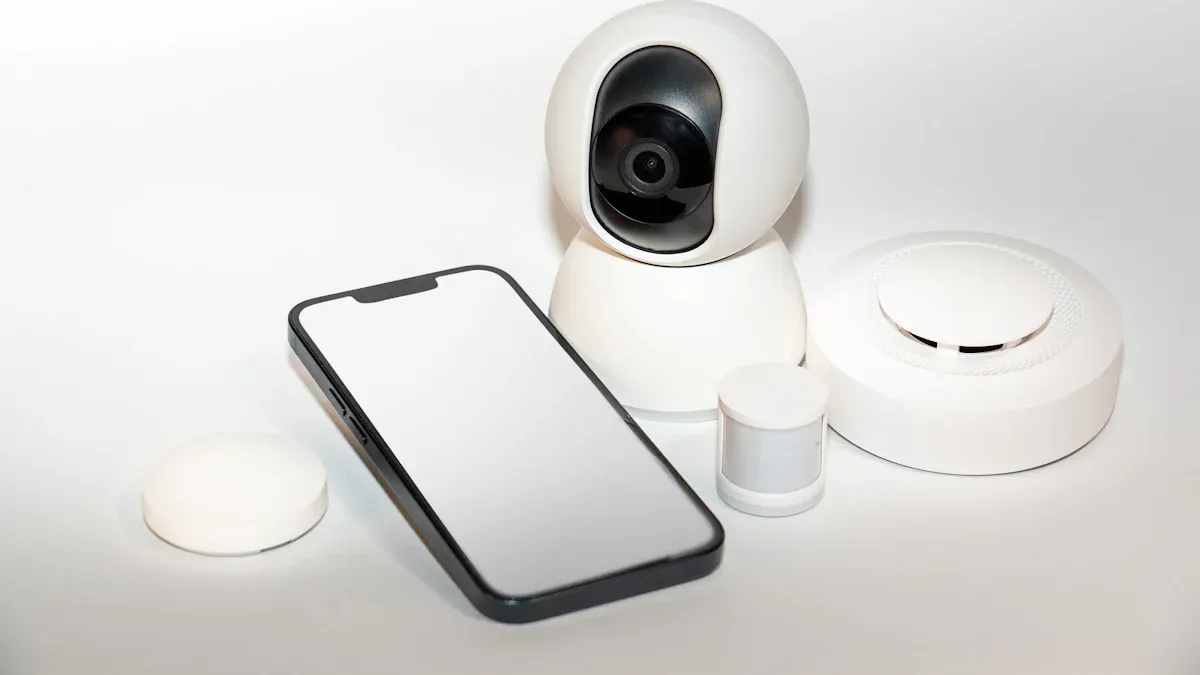
Smart tire sensors use new technology to check your tires. They help you get the right tread depth and keep your tires safe. There are three main types of sensors in these systems: embedded sensors, laser scanning, and virtual sensors. Each type checks tread depth, tire pressure, and temperature in its own way.
Embedded Sensors
Embedded sensors are inside your tire or connect to the TPMS. Companies like Continental AG use them to watch tire pressure and tread depth. Some sensors go in the valve. Others fit under the tread. They watch how your tire rolls and changes over time. When the tread gets low, the sensor sees this and sends a warning.
You can find different kinds of embedded sensors:
Acceleration sensors watch how the tire moves and help guess tread wear.
Optical sensors use light to see how the tire touches the road.
Acoustic sensors listen for changes in the tire’s surface to find damage.
Piezoelectric sensors feel how much the tire bends.
Flexible sensors, like laser-induced graphene, fit many tire shapes and give live data.
These sensors work together to give you updates on tread depth and tire health. They help you find problems early and keep your car safe.
Laser Scanning
Laser scanning uses a laser and a lens to scan your tire. The laser bounces off the tread, and the sensor measures the distance. This method uses laser triangulation and special light to make a 3D map of your tread. You get fast, no-touch, and very accurate readings—up to 0.1 mm.
Handheld tire tread depth sensors often use this technology. You hold the device near the tire, and it scans the grooves by itself. The device shows results on a touchscreen with color charts and numbers. You can use it alone or with your phone to get reports and tips. Laser scanning works in rain and gives quick results for all four tires. It is faster and more accurate than old gauges and gives instant reports.
Technology Used | Measurement Accuracy | Inspection Time | Report Generation |
|---|---|---|---|
Mechanical Gauge | Low | ~6 min | No |
Laser Imaging | High (0.1 mm) | 90 sec | Yes |
Laser scanning helps you check tread depth, uneven wear, and wheel alignment.
Virtual Sensors
Virtual sensors use your car’s systems to guess tread depth and wear. You do not need extra hardware. These sensors collect data from wheel speed, angle, and RPM. Software looks at this data to give you real-time tread readings and alerts.
Virtual sensors use machine learning to find patterns in tire wear. They mix signals from different sensors, remove noise, and use deep learning to guess tread depth. You get alerts before your tires are unsafe. This helps you plan tire changes, avoid accidents, and save money.
Tip: Virtual sensors are good for fleets and connected cars. They send tire health data to the cloud, so you or your fleet manager can track tread wear and plan repairs.
Smart tire sensors, whether embedded, laser-based, or virtual, give you a full view of your tire’s health. They help you stay safe, save time, and keep your tires working well.
Tread Wear Indicator Benefits

Safety
Tires are important for your safety when you drive. A tread wear indicator warns you early if your tires are getting worn out. This lets you fix problems before they become dangerous. Smart tire sensors check tread depth, pressure, and temperature all the time. You get alerts right away if something is wrong. This helps you avoid accidents from bad or flat tires.
Safety alerts tell you about problems before they get serious.
Real-time alerts help you fix tire issues quickly.
Tread wear indicators show when it’s time to get new tires.
Good tread depth stops skidding and keeps you in control.
You follow the law and avoid tickets by keeping safe tread depth.
Safety Benefit | Explanation |
|---|---|
Tells you about tire wear before it’s a big problem. | |
Safer Driving in Adverse Weather | Helps your tires grip the road in rain or snow. |
Reduced Braking Distance | Makes your car stop faster, even on wet roads. |
Prevention of Hydroplaning | Grooves move water away, so you don’t lose control. |
Real-Time Monitoring | Lets you change tires on time and stay safe. |
Legal Compliance | Helps you follow the law and not get fined. |
Experts say tread wear indicators help lower car accidents. You get alerts before tires are unsafe, so you can change them in time. This technology helps your car grip the road and stop better, making every drive safer.
Maintenance
Smart tire sensors and tread wear indicators make tire care easier and cheaper. You do not have to check each tire by hand anymore. The handheld monitor uses laser imaging to measure tread depth fast and without touching. You see results on a screen or your phone. You also get reports with tips for tire care.
Finding worn tires early stops breakdowns and saves money.
The device finds uneven wear, so you can fix alignment or air problems.
Digital reports help you plan tire changes and rotations.
Fleets using these systems save up to $1,493 per vehicle.
Tip: Using a tread wear indicator often helps your tires last longer and keeps your car working.
You can use the device alone or with your phone for more details. Reports show how worn your tires are and give you advice for care. This helps you avoid sudden problems and keeps your car running well.
Fuel Efficiency
Tread wear indicators also help you use less fuel. When your tires are in good shape, your car moves easier. Smart tire sensors watch tread depth, pressure, and temperature all the time. You get alerts if your tires need air or need to be changed, so you can fix them fast.
Good tread patterns help your car use less fuel.
Real-time checks help you keep tires at the right pressure and depth.
Some smart systems can even change tire pressure by themselves.
Good tire care helps the planet by making less waste and pollution.
Using a tread wear indicator helps your car run better and saves gas. You also help the environment by making your tires last longer and lowering pollution.
Smart Tire Sensors Applications
Individual Vehicles
Smart tire sensors help make your car safer and easier to drive. Most new cars have a Tire Pressure Monitoring System, or TPMS. This system checks your tire pressure all the time. If the pressure gets too low, a warning light comes on. This helps you avoid accidents and saves gas. It also helps your tires last longer.
Smart tire sensors do more than check pressure. They also measure tread depth and tire temperature. Some can even find punctures. You get alerts right away if something is wrong. This lets you fix problems before they get worse or cost more. Some special devices use lasers to scan your tires. You do not have to touch the tire. You see the results on a screen or your phone. These devices use a laser, a lens, and a touchscreen. They give you fast and correct readings. You can use them alone or with your phone for more details. Car owners, mechanics, and shops all use these tools.
Main uses in your own car:
Always checking pressure, tread depth, and temperature
Alerts for low pressure or worn tread
Reminders for tire care and replacement
Easy reports and tips for taking care of tires
Fleet Operations
Smart tire sensors help fleets save money and keep drivers safe. These sensors watch tire health on all vehicles. You get alerts for leaks, heat, or other problems early. This stops breakdowns and emergency repairs.
Smart tire monitoring can make tires last up to 30% longer. It also helps save fuel. You can plan repairs using real data, not just guesses. Many fleets have fewer accidents and spend less money after using these systems. The table below shows some big benefits for fleets:
Benefit Category | Description / Impact | Example Result |
|---|---|---|
Real-time monitoring | Early alerts for leaks and heat | Prevents failures |
Fuel efficiency | Proper inflation saves fuel | 15% fuel savings in some fleets |
Extended tire life | Early detection adds 20-30% to tire lifespan | 22-30% longer tire life |
Reduced downtime | Fewer blowouts and emergency repairs | |
Maintenance scheduling | Automated by tire health data | Better resource use |
Safety improvements | Fewer accidents and blowouts | 45% fewer safety incidents |
Cost savings | Lower emergency and replacement costs | $147,000 saved in one year |
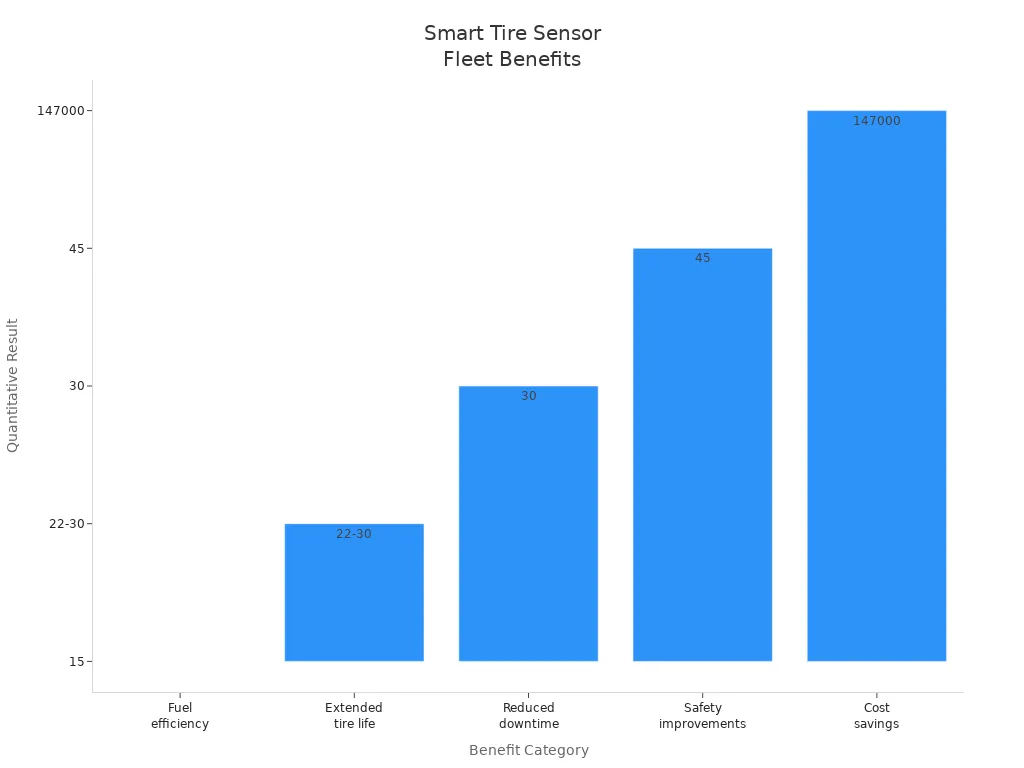
Tip: Smart tire monitoring can stop up to 83% of tire failures. It can also cut unsafe driving days by over 90%.
Integration with Telematics
You can link smart tire sensors to telematics for more control. These sensors send data like pressure, temperature, and tread depth to a main system. They use Bluetooth, RFID, or cellular networks. Telematics gateways collect this data and send it to the cloud. You can see all your tire data on a dashboard right away.
Main features of telematics:
Alerts for pressure, temperature, and tread problems
Automatic repair planning using sensor data
Dashboards that are easy to use and read
Safe data sharing with encryption and anti-tampering
APIs to connect with fleet management software
With telematics, you make better choices about repairs and safety. You get alerts on your phone or computer if a tire needs help. This keeps your fleet working well and safely.
Smart tire tread depth detectors make driving safer for everyone. These tools use laser imaging and scan your tires without touching them. You get quick and correct results on a screen or your phone. You can find tread wear, spot alignment issues, and see if your tires need air. Experts say these detectors help stop accidents and make tire care easier to plan. Many fleets use them to save money and keep drivers safe. Car owners, technicians, and fleet managers can all use these detectors. Try smart tire sensors to help you drive safer and take care of your tires.
Main benefits:
Real-time safety alerts
Fast, accurate tread checks
Easy reports for better tire care
FAQ
How does a handheld smart tire tread depth detector measure tread depth?
The device uses a laser imaging algorithm. It scans your tire without touching it. It finds the grooves and measures how deep they are. You see the results on a screen right away. This way is fast and gives you very accurate numbers.
What features does the device have?
The device has a laser emitter and an optical lens. It also has a touchscreen, a power button, and a USB Type-C charging port. You can use Bluetooth or Wi-Fi to connect it. The screen shows numbers, color charts, and battery life. You can pair it with your phone or tablet to get reports.
Who can use this smart tire tread depth detector?
Technicians, car owners, and auto repair shops use it. Tire shops, fleets, and inspection stations also use it. You can check your own tires or ask a professional. The device works for many kinds of vehicles.
How is this better than a traditional mechanical gauge?
Feature | Mechanical Gauge | Smart Detector |
|---|---|---|
Accuracy | Low | High (0.1 mm) |
Speed | Slow | Fast (90 seconds) |
Reports | None | Detailed, with advice |
Connectivity | None | Bluetooth/Wi-Fi |
You get results faster and they are more accurate. You also get easy-to-read reports.
What inspection functions does the device offer?
The device gives you alerts for tire replacement and wheel alignment. It also warns you if your tires have too much or too little air. It checks tread wear and finds uneven spots. You get tips for taking care of your tires. You can see all the results on the device or in the app.

